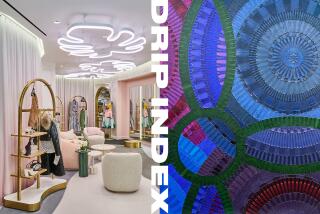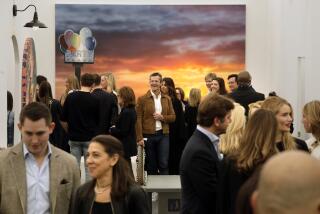Whither the Biennial Bandwagon? : Critical, Popular Response Will Help Determine Art Exhibition’s Future
Among the long-lamented gaps in Los Angeles’ never-quite-complete art scene is an annual or biennial exhibition to showcase local talent. To provide a nourishing environment for visual artists and encourage a valuable cultural asset, the city must stage a really big show of L.A. art as a regular, ongoing event, the argument goes.
“LAX: The Los Angeles Exhibition,” opening this week with receptions in seven museums and galleries, was born of this contention. And indeed the mega-show would appear to fulfill some boosters’ dreams.
Spearheaded by the Municipal Art Gallery, the exhibition “celebrates the strength and diversity that characterize artistic production here,” according to former Muni director Edward Leffingwell, who served as project director. Works by 56 artists selected by a dozen curators are in the show, which sprawls from East Los Angeles to Santa Monica.
The exhibition catalogue bears silent testimony to the mountain of work that has gone into “LAX.” In addition to the expected reproductions of artworks and essays by curators, Leffingwell, artist and writer Fred Fehlau and poet Amy Gerstler have contributed a rambling text about art in Los Angeles and related issues, compiled from facsimile correspondence that took place in July and August.
“Everything’s in the catalogue,” Leffingwell said, leafing through the 126 pages and pointing out photographs that document Los Angeles art history. There’s even a fold-out map picturing the exhibition venues and locations, he noted.
But the point of greatest interest to art aficionados who take a long view of the city’s cultural health is addressed in the first sentence of Leffingwell’s introductory essay: “ ‘LAX: The Los Angeles Exhibition’ is the first installment of what is intended as an ongoing, multi-institutional, biennial program.”
Intended is the key word. “LAX” organizers meant to create a biennial, but the Municipal Art Gallery has been turned upside down since the exhibition was conceived. “We will do anything we can to see that ‘LAX’ becomes a biennial. There’s no reason we wouldn’t continue,” said Adolfo V. Nodal, general manager of the city’s Cultural Affairs Department, which oversees the Muni. But the crucial issue is who will take charge of the exhibition if it is to develop into a major, regularly scheduled event.
Leffingwell--who only recently joined the biennial bandwagon--would like to make “LAX” his baby, but he was forced out of his job as director of the Muni. Nodal in July eliminated Leffingwell’s position and put him in charge of public art during a budgetary squeeze. Leffingwell declined the transfer and resigned, but agreed to remain through February as a consultant in order to complete major projects in process--including “LAX.” Since his resignation, he has been paid by the Directors of the Municipal Art Gallery, a longstanding private support group. Meanwhile, the Muni is left with no director, which makes the gallery an unlikely candidate to coordinate an ongoing biennial.
Another problem is that the Muni’s support group, which has championed a biennial for several years, appears to be pulling out of the gallery in the wake of Leffingwell’s resignation. “It’s clear that Al doesn’t want us at the gallery anymore,” attorney and board president Joseph R. Austin said.
“That’s not true,” Nodal said. “How could we not want a support group?” Nodal said he had been working with some members of the group and hoped to renew the city’s relationship with the directors. (The board raised $225,000 for exhibitions in the 1991-92 fiscal year and it had budgeted $400,000 for 1992-93 before its relationship with the Muni came into question.)
Meanwhile, Austin said the 25-member group will meet after the holidays to chart its direction. “We are all committed to Southern California art and we enjoy working together, so we would like to continue,” he said. One option is becoming a free-floating support group; another is backing a different organization, Austin said. Supporting future versions of “LAX” is also a possibility. “It looks exciting on paper, although it’s smaller that it should be, but we’ll have to see how it goes,” he said.
As for the first--and possibly last--”LAX,” seven organizations have planned receptions this week. Scheduled today are openings at USC’s Fisher Gallery (6-8 p.m.) and the Santa Monica Museum of Art (7-9 p.m.). Friday receptions are planned at the Japanese American Cultural and Community Center (6-9 p.m.), Los Angeles Contemporary Exhibitions and Plaza de la Raza (both at 7-10 p.m.). Saturday celebrations are scheduled at Otis School of Art and Design (3-6 p.m.) and the Municipal Art Gallery and adjacent Junior Arts Center Gallery (6-8 p.m.).
“There is no overall thematic structure,” Leffingwell said of the exhibition, which the Muni directors persuaded him to organize. Leading members of the support group had actually envisioned two alternating biennials, one invitational, the other a juried competition. But Leffingwell said he had resisted because he thought the Muni was too small for the project and he didn’t think it would differ significantly from his program.
When he decided to tackle the project, Leffingwell enlisted the help of the other institutions but did not tell them what to show. Participating directors and curators coordinated their efforts to avoid duplication but originated their own presentations, he said.
Individual shows vary from an eight-year survey of Frank Romero’s work at Plaza de la Raza to rather eclectic group assemblies at the Muni and LACE. Otis is displaying paintings by 11 artists who combine abstraction with popular imagery and text, while the JACCC is devoting its gallery to the work of David Roesler and Joseph Shuldiner, who have adapted Asian art-making traditions to contemporary American art.
The Santa Monica Museum of Art offers “Body Politic” and “Visiting Hours,” two shows addressing questions of physical and sexual identity. USC has two large installations, Buzz Spector’s “Bibliography” and Ken Goldberg’s and Margaret Lazzari’s “Power and Water.”
The catalogue and a video program, to be shown at each venue, will help visitors understand the multipart exhibition as a whole, Leffingwell said, while maps will provide a guide. The show is sponsored in part by BMW of North America Inc.
Critical and popular response will be a factor in determining the exhibition’s future, Leffingwell said. But even if it is a roaring success--and if the reorganized Muni Directors and BMW renew their support or some other agency, such as the National Endowment for Arts, steps in with funds--turning “LAX” into a biennial would require a lot of planning.
One question is whether a biennial art exhibition must be based at an institution or whether a different kind of organizational structure would work, Leffingwell said. “There are precedents for successful collaborative ventures in Los Angeles,” he said, citing the Olympic Arts Festival in 1984, the Los Angeles Festival in 1990 and Artes de Mexico in 1991 as possible models.
More to Read
The biggest entertainment stories
Get our big stories about Hollywood, film, television, music, arts, culture and more right in your inbox as soon as they publish.
You may occasionally receive promotional content from the Los Angeles Times.










